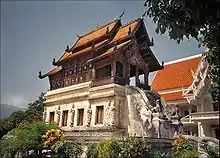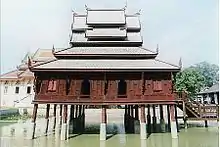Ho trai
A ho trai (Thai: หอไตร) is the library of a Thai Buddhist temple.

A ho trai can come in different shapes and sizes.
For many centuries, the sacred Tipiṭaka scriptures had been written on palm leaves. To preserve the scriptures against humidity and against termites, the library was often built on columns to raise the storage from the ground. Bricks were preferably used in constructions to battle termites. Sometimes the ho trai would be built, especially for this reason, above man-made ponds.
Traditionally, the Tipiṭaka scriptures consisted of individual palm leaves, each measuring around 50 centimetres (20 in) in length and around 4 to 6 centimetres (1.6 to 2.4 in) in width. They were perforated and threaded in order to combine them in stacks of 20 to 40 pages. These stacks are kept pressed between two pieces of teakwood which is then wrapped in cloth and stored in a special bookcase. These bookcases are sometimes exquisitely crafted with mother-of-pearl inlay or with gold leaf applied on black lacquer. Beautiful examples of bookcases can be seen in the Bangkok National Museum. Modern Tipiṭaka are now printed as books.
Gallery
 The Ho trai of Wat Yai Suwannaramt in Phetchaburi built above a pond
The Ho trai of Wat Yai Suwannaramt in Phetchaburi built above a pond The Ho trai of Wat Hua Khuang in Nan
The Ho trai of Wat Hua Khuang in Nan The Ho trai of Wat Tung Sri Muang in Ubon Ratchathani
The Ho trai of Wat Tung Sri Muang in Ubon Ratchathani The interior of the Ho trai of Wat Rakhang, Khet Bangkok Noi, Bangkok
The interior of the Ho trai of Wat Rakhang, Khet Bangkok Noi, Bangkok The "Ho trai" of Wat Apson Sawan, khet Phasi Charoen, Bangkok
The "Ho trai" of Wat Apson Sawan, khet Phasi Charoen, Bangkok